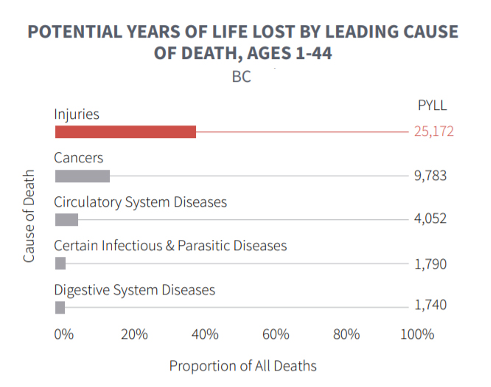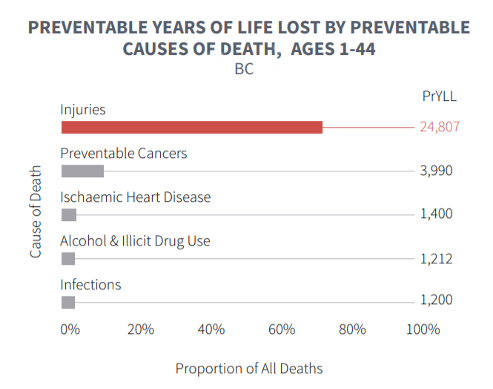THE CASE FOR INJURY PREVENTION
Everyone has a role in injury prevention—working collaboratively to implement evidence-based solutions will save lives and prevent disabilities.
INJURIES CAN HAPPEN ANYWHERE
WHAT IS AN INJURY?
An injury is any physical damage to the body. This can be the result of excessive force, heat, electricity, chemicals, or radiation. Injury can also be caused by a lack of energy, such as heat or oxygen.
Injuries can be classified as inflicted, either self-inflicted or inflicted by another person, or unintentional. It is sometimes unclear if the injury was inflicted or not.
Common causes of injury include falls, motor vehicle crashes, poisoning, drowning, assaults, sport or recreation-related injury, and self-harm.
Injuries can be mild, such as scrapes or bruises, or more severe, such as brain injury, resulting in disability or death. Common injuries include cuts and bruises, burns and scalds, fractures, sprains and strains, and concussion.
How do we know what we know?
- How injuries happen
- Type of injuries
- Who are injured
- Why injuries happen
- When injuries happen
HOW ARE BRITISH COLUMBIANS GETTING INJURED?
The top 5 causes of injury, for all ages:
HOSPITALIZATIONS*
Falls
DEATHS*
Poisoning
Transport-related
Falls
Suicide and Self-harm


Suicide and Self-harm
Poisoning
Transport-related
Overexertion
*as of 2021/22
Drowning
*as of 2020
As of 2019/20, the leading causes of hospitalization are:
-
- Falls among children and older adults
- Transport-related among adults 25 to 34 years
- Self-harm among young adults 15 to 24 years
As of 2018, the leading causes of injury death are:
-
- Transport-related for children and youth
- Unintentional poisoning for youth and adults
- Falls for older adults
WHAT IS THE BURDEN OF INJURY IN BRITISH COLUMBIA?
Injuries exact a huge cost, both in lives & lost potential, and in financial costs.
More than:
- 2,000 British Columbians die from injury each year
- 35,000 British Columbians are hospitalized for an injury each year
- 8,000 British Columbians are left with a permanent disability

2,000 people is the equivalent of 5 jetliners crashing with all lives lost each year or 1 person dying every 4 hours.
Injuries can affect:
families
communities
schools
workplaces
Injuries among children, youth, and young adults can result in years of lost potential.


Potential Years of Life Lost (PYLL) captures the number of years of life lost due to death from an adverse event.
Preventable Years of Life Lost (PrYLL) is calculated in the same way as PYLL, except it considers only preventable causes of deaths.
Avoidable deaths is a term used to speak to the effectiveness of health care, health promotion and disease prevention policies in preventing premature deaths. It counts the number of deaths for every 100,000 people that could potentially have been avoided through better treatment and prevention efforts.
Disability-Adjusted Life Year (DALY) quantifies the burden of a negative event on society (e.g., natural disasters, injuries, illnesses). In essence, one DALY is one year of healthy life lost as a result of death or disability.
WHAT IS THE COST OF INJURY?
Each year, preventable injuries cost British Columbians over 4 billion dollars in total costs.1
This is equal to 11 million dollars per day.
Total costs of injury are made up of direct and indirect costs.
- Direct costs are the costs to the health care system, including diagnosis, treatment, continuing care, rehabilitation, and costs of injury-related death.
- Indirect costs are the economic outputs lost because of injury-related work disability, or premature death.
- Lowering speed limits on our roads to reduce the risk of injury from motor vehicle incidents.
- The use of personal protective equipment, such as mouth guards, helmets, eye protection and wrist guards in sport and recreation, and work activities.
- The presence of working smoke detectors in the home can reduce burn injuries.
- Enacting province-wide policy on seatbelt usage has already saved countless lives.
- Non-lethal dose packaging and child-proof containers have saved many children from poisoning.
BUT WE KNOW SOMETHING
IMPORTANT:
INJURIES SHOULD NOT BE THOUGHT OF AS “ACCIDENTS.”
- Males are more at risk of serious injuries than females.
- Those that live in lower-income neighbouroods are more at risk than those living in higher-income neighbourhoods.
- Other risk factors for injury include age, and our understanding and attitudes towards risk.
Determining and acting upon the upstream investment for injury prevention will translate to injury costs avoided and financial resources available for reallocation to other important health care areas. Evidence-based solutions are available.
WHAT CAN WE DO ABOUT IT?
A multi-strategy approach is needed to reduce the impact of injuries.
Learn more about what the BC Injury Research and Prevention Unit is doing to reduce the burden of injuries
WHAT ARE WE DOING TO PREVENT INJURIES?
1. Fahra Rajabali, MSc, Emilie Beaulieu, MD, Jennifer Smith, BFA, Ian Pike, PhD. The economic burden of injuries in British Columbia: Applying evidence to practice. BCMJ, Vol. 60, No. 7, September, 2018, Page(s) 358-364 – Clinical Articles.



